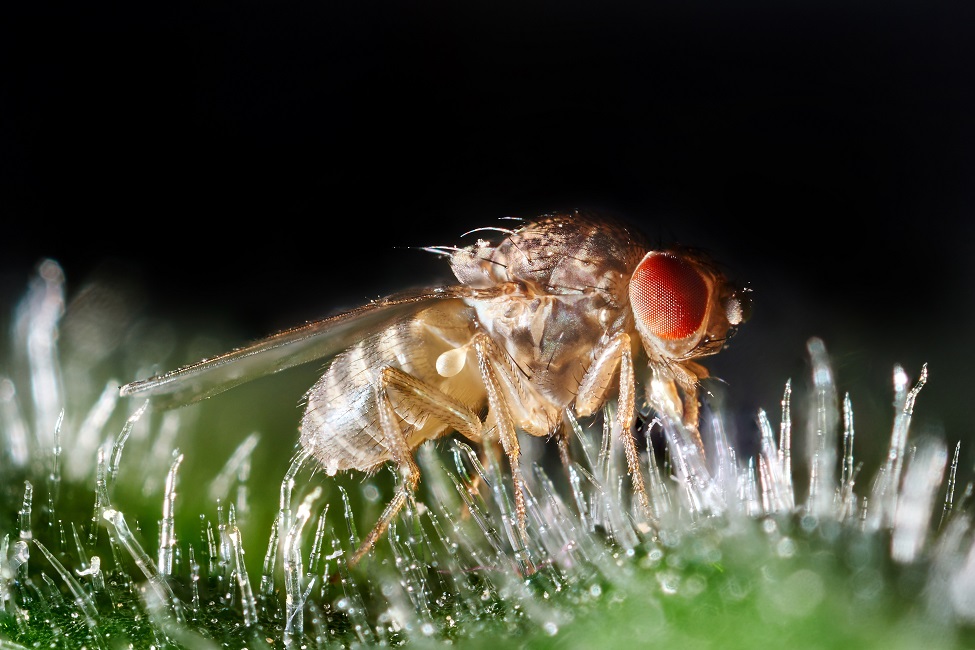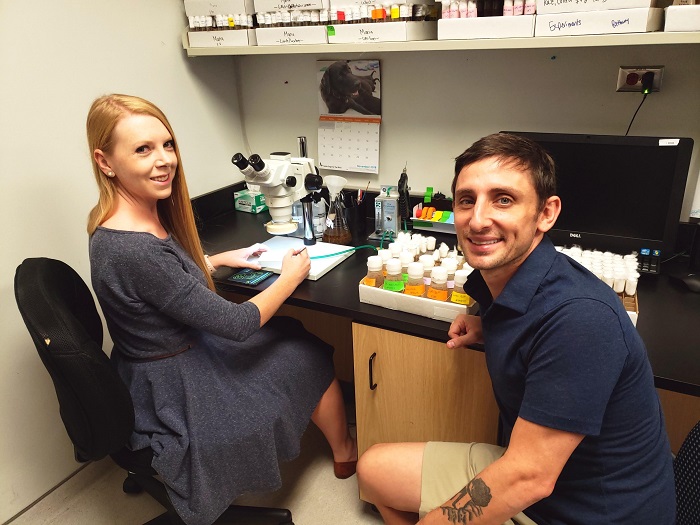Can't Sleep? Fruit Flies, Energy Drinks Offer New Clues

Like humans, fruit flies are active during the day, sleep at night and have similar sleep characteristics.
Sleep is an essential behavioral state in animals ranging from invertebrates to humans. It is critical for immune function, stable metabolism, brain repair, learning and memory. Over the course of a lifetime, more than 30 percent of people will experience a sleep disorder, which is associated with a number of diseases including Alzheimer’s, type 2 diabetes, and cardiovascular disease.
There is growing evidence that glial cells (or glia), long thought to simply “support” neurons within the brain, are actually quite important for diverse aspects of sleep regulation. Thanks to Drosophila melanogaster (more affectionately known as the fruit fly), research teams at Florida Atlantic University and McGill University in Quebec have discovered a new mechanism regulating sleep that involves glia and their ability to manage a common ingredient found in many energy drinks like Red Bull™.
Fruit flies share 75 percent of the genes that cause diseases in humans and display all of the behavioral and physiological characteristics of sleep. For the study, published in the journal Current Biology , the researchers sought to identify new genes affecting sleep and wakefulness in fruit flies. With this approach, they uncovered a gene that encodes the membrane transport protein known as excitatory amino acid transporter 2 or Eaat2.
They found that Eaat2 promotes wakefulness in fruit flies by limiting the length and intensity of sleep periods. They also discovered that it does this by controlling the movement of taurine – the ingredient found in many energy drinks – into glial cells of the fly brain. In humans, taurine is consistently elevated in blood and urine of sleep-deprived people, but it is unknown if taurine levels also change in the brain after sleep deprivation.
Like humans, fruit flies are highly active during the day and sleep throughout the night. The authors found that disruption of Eaat2 in fruit flies caused excess daytime sleepiness.
“Daytime sleep is more fragmented than nighttime sleep, and disrupting Eaat2 function led to daytime sleep that mimics sleep typically observed only during the night,” said Bethany A. Stahl, Ph.D., a lead author on the study and a post-doctoral fellow in the lab of Alex C. Keene, Ph.D., an associate professor of biological sciences in FAU’s Charles E. Schmidt College of Science and a member of the Jupiter Life Science Initiative (JSLI).

Study co-authors Bethany A. Stahl, Ph.D., a post-doctoral fellow at FAU, and Alex C. Keene, Ph.D., an associate professor of biological sciences in FAU’s Charles E. Schmidt College of Science and a member of the Jupiter Life Science Initiative.
“About 70 million Americans suffer from sleep disorders, and we believe that raising awareness of the importance of understanding fundamental mechanisms of sleep is an important issue globally,” said Keene.
To determine the role of Eaat2 in metabolic regulation, the researchers simultaneously measured sleep and CO₂ output from single flies.
“We think the identification of Eaat2 as a modulator of sleep will be important for researchers who study sleep regulation, sleep-dependent changes in metabolism, and perhaps physicians treating patients with sleep disorders,” said Keene. “It suggests sleep researchers need to look beyond the role of neurons to examine how glial cells control our sleep-wake regulation.”
The team found that Eaat2 works in specific glial cells of the fly brain, rather than in neurons.
“Our research adds wakefulness to the growing list of fruit fly behaviors where glial cells play an important regulatory role, which includes circadian rhythms, movement, courtship, learning and memory,” said Emilie Peco, Ph.D., who co-led the study and is a research associate in the lab of Don van Meyel, Ph.D., a professor of neurology at the McGill Centre for Research in Neuroscience, and the BRaIN Program of the Research Institute of the McGill University Health Centre.
Eaat2 was previously shown to transport taurine. So to test if taurine might explain how Eaat2 affects sleep, Stahl fed taurine to some flies and found they slept more during the daytime than the control flies, but only if Eaat2 was present.
“The study led by Dr. Stahl and Dr. Peco focuses on fundamental mechanisms of sleep and glial cells in flies, but we expect our discovery will fuel research to determine if a mechanism involving the transport of taurine to and from glial cells might influence sleep in humans,” said van Meyel. “Even if you don’t indulge in energy drinks, there is a lot of taurine in the human brain, and what it does there is not understood all that well.”
Study co-authors are Sejal Davla, Ph.D., McGill University; and Kazuma Murakami, Ph.D., and Nicholàs A. Caicedo Moreno, Ph.D., both at FAU. The collaboration between the teams at FAU and McGill developed organically from the Keene lab’s focus on sleep research and the van Meyel lab’s expertise in glial cells and membrane transport proteins.
This work was supported by the National Institutes of Health (NIH), the Canadian Institutes of Health Research (CIHR), the Natural Sciences and Engineering Research Council of Canada, and the Canada Foundation for Innovation.
JLSI is aimed at building educational and research capabilities in the life sciences on FAU’s John D. MacArthur Campus in Jupiter, and is a collaborative effort between the Charles E. Schmidt College of Science and the Harriet L. Wilkes Honors College.
-FAU-
Tags: jupiter | research | faculty and staff | science | students